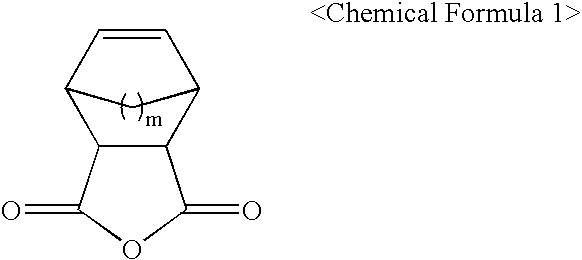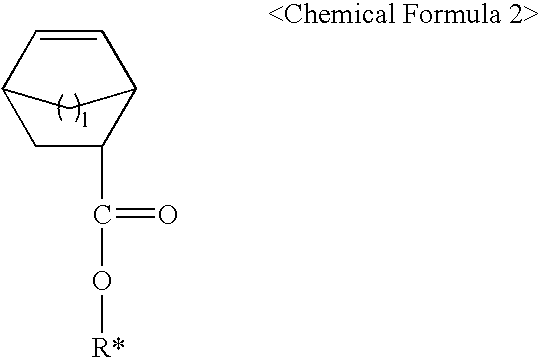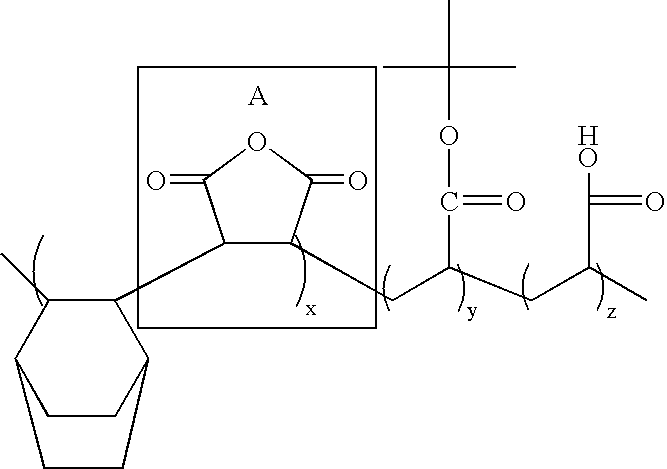Polymers for photoresist and photoresist compositions using the same
a technology of photoresist and polymer, which is applied in the field of photoresist monomers and polymers formed therefrom, and photoresist compositions, can solve the problems of poor etching resistance, difficult to synthesize a polymer that satisfies all of these requirements, and difficulties in the development process, and achieves excellent etching resistance, adhesiveness and photosensitivity.
- Summary
- Abstract
- Description
- Claims
- Application Information
AI Technical Summary
Benefits of technology
Problems solved by technology
Method used
Image
Examples
example 1
Synthesis of Poly(cis-5-norbornene-endo-2,3-dicarboxylic anhydride / tert-butyl 5-norbornene-2-carboxylate / maleic anhydride / mono-methyl cis-5-norbornene-endo-2,3-dicarboxylate / 5-norbornene-2-carboxylic Acid)
[0053]Maleic anhydride (1.0 mole), cis-5-norbornene-endo-2,3-dicarboxylic anhydride (0.2 mole), mono-methyl cis-5-norbornene-endo-2,3-dicarboxylate (0.15 mole) and tert-butyl-5-norbornene-2-carboxylate (0.65 mole) are dissolved in tetrahydrofuran. Then, 0.5 to 10 g of AIBN (azobisisobutyronitrile) as a polymerization initiator is added thereto, and the resultant mixture is reacted at about 60-70° C. for 4 to 24 hours under nitrogen or argon atmosphere. The polymer thus obtained is precipitated from ethyl ether or hexane, and dried to obtain the compound represented by the following Chemical Formula 101.
example 2
Synthesis of Poly(cis-5-norbornene-endo-2,3-dicarboxylic anhydride / tert-butyl 5-norbornene-2-carboxylate / maleic anhydride / mono-methyl bicyclo[2,2,2]oct-5-ene-2,3-dicarboxlate / 5-norbornene-2-carboxylic Acid)
[0054]The procedure of Example 1 is repeated but using mono-methyl-bicyclo[2,2,2]oct-5-ene-2,3-dicarboxylate (0.15 mole) instead of mono-methyl cis-5-norbornene-endo-2,3-dicarboxylate (0.15 mole), to obtain the compound represented by the following Chemical Formula 102.
example 3
Synthesis of Poly(cis-5-norbornene-endo-2,3-dicarboxylic anhydride / tert-butyl 5-norbornene-2-carboxylate / maleic anhydride / 5-norbornene-2,2-dimethanol / 5-norbornene-2-carboxylic Acid)
[0055]Maleic anhydride (1.0 mole), cis-5-norbornene-endo-2,3-dicarboxylic anhydride (0.2 mole), 5-norbornene-2,2-dimethanol (0.1 mole), tert-butyl 5-norbornene-2-carboxylate (0.65 mole) and 5-norbornene-2-carboxylic acid (0.05 mole) are dissolved in tetrahydrofuran.
[0056]Then, 0.5 to 10 g of AIBN (azobisisobutyronitrile) as a polymerization initiator is added thereto, and the resultant mixture is reacted at about 60-70° C. for 4 to 24 hours under nitrogen or argon atmosphere. The polymer thus obtained is precipitated from ethyl ether or hexane, and dried to obtain the compound represented by the following Chemical Formula 103.
PUM
| Property | Measurement | Unit |
|---|---|---|
| wavelength | aaaaa | aaaaa |
| thickness | aaaaa | aaaaa |
| thickness | aaaaa | aaaaa |
Abstract
Description
Claims
Application Information
 Login to View More
Login to View More - R&D
- Intellectual Property
- Life Sciences
- Materials
- Tech Scout
- Unparalleled Data Quality
- Higher Quality Content
- 60% Fewer Hallucinations
Browse by: Latest US Patents, China's latest patents, Technical Efficacy Thesaurus, Application Domain, Technology Topic, Popular Technical Reports.
© 2025 PatSnap. All rights reserved.Legal|Privacy policy|Modern Slavery Act Transparency Statement|Sitemap|About US| Contact US: help@patsnap.com



